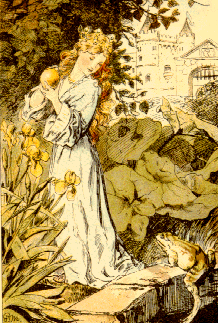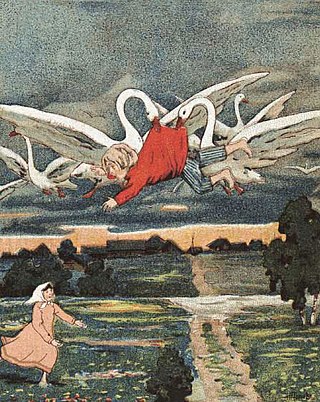
"The Frog Prince; or, Iron Henry" is a German fairy tale collected by the Brothers Grimm and published in 1812 in Grimm's Fairy Tales. Traditionally, it is the first story in their folktale collection. The tale is classified as Aarne-Thompson type 440.
The Aarne–Thompson–Uther Index is a catalogue of folktale types used in folklore studies. The ATU Index is the product of a series of revisions and expansions by an international group of scholars: originally composed in German by Finnish folklorist Antti Aarne (1910), the index was translated into English, revised, and expanded by American folklorist Stith Thompson, and later further revised and expanded by German folklorist Hans-Jörg Uther (2004). The ATU Index, along with Thompson's Motif-Index of Folk-Literature (1932)—with which it is used in tandem—is an essential tool for folklorists.

"Maid Maleen" is a German fairy tale collected by the Brothers Grimm, number 198.

The Lute Player, The Tsaritsa Harpist or The Tsaritsa who Played the Gusli, is a Russian fairy tale. It was published by Alexander Afanasyev in his collection Russian Fairy Tales, as number 338. Andrew Lang included it in The Violet Fairy Book (1901).
Boots and His Brothers is a Norwegian fairy tale collected by Peter Christen Asbjørnsen and Jørgen Moe in their Norske Folkeeventyr.

The Mermaid and the Boy is a Sámi fairy tale first collected in the mid-19th century. It tells the story of a prince unknowingly promised to a mermaid before he was born, then obtains magical powers to transform into animals later in the story.

The Magic Swan Geese is a Russian fairy tale collected by Alexander Afanasyev in Narodnye russkie skazki, numbered 113.
The Little Bull-Calf is an English Romani fairy tale collected by Joseph Jacobs in More English Fairy Tales.

The Norka is a Russian and Ukrainian fairy tale published by Alexander Afanasyev in his collection of Russian Fairy Tales, numbered 132.
The Enchanted Maiden is a Portuguese fairy tale collected by Zófimo Consiglieri Pedroso in Portuguese Folk-Tales.

"The Gnome" is a German fairy tale collected by the Brothers Grimm in Grimm's Fairy Tales, tale number 91.
"The Three Snake-Leaves" is a German fairy tale collected by the Brothers Grimm, tale number 16. It is Aarne-Thompson type 612, "The Three Snake-Leaves".
The Motif-Index of Folk-Literature is a six volume catalogue of motifs, granular elements of folklore, composed by American folklorist Stith Thompson. Often referred to as Thompson's motif-index, the catalogue has been extensively used in folklore studies, where folklorists commonly use it in tandem with the Aarne–Thompson–Uther Index (ATU), an index used for folktale type analysis.
Verlioka or wyrlook is an East Slavic fairy tale collected by Alexander Afanasyev in Narodnye russkie skazki (1855–63). It is classified in the Aarne-Thompson-Uther Index as tale type ATU 210*, "Verlioka".
Hans-Jörg Uther is a German literary scholar and folklorist.
The Calumniated Wife is a motif in traditional narratives, numbered K2110.1 in Stith Thompson's Motif-Index of Folk-Literature. It entails a wife being falsely accused of, and often punished for, some crime or sin. This motif is at the centre of a number of traditional plots, being associated with tale-types 705–712 in the Aarne–Thompson–Uther Index of tale-types.
In folkloristics, "The Animal as Bridegroom" refers to a group of folk and fairy tales about a human woman marrying or being betrothed to an animal. The animal is revealed to be a human prince in disguise or under a curse. Most of these tales are grouped in the international system of Aarne-Thompson-Uther Index under type ATU 425, "The Search for the Lost Husband". Some subtypes exist in the international classification as independent stories, but they sometimes don't adhere to a fixed typing.

The Dog in the Sea, also known as The Dog and the Sailor is a northern European fairy tale classified as ATU 540, "The Dog in the Sea".
The Story of the Abandoned Princess is a Norwegian fairy tale published by Norwegian author Camilla Collet. It is related to the cycle of the Animal as Bridegroom and distantly related to the Graeco-Roman myth of Cupid and Psyche, in that the heroine is forced to perform difficult tasks for a witch.
The Belbati Princess is an Indian folktale collected by Cecil Henry Bompas. The tale is a local form of tale type ATU 408, "The Love for Three Oranges", of the international Aarne-Thompson-Uther Index. As with The Three Oranges, the tale deals with a prince's search for a bride that lives in a fruit, who is replaced by a false bride and goes through a cycle of incarnations, until she regains physical form again. Variants are known across India with other species of fruits.








